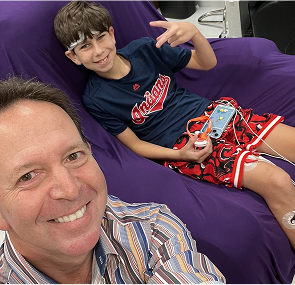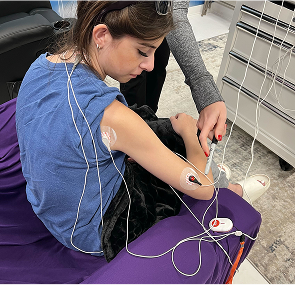Diabetic Neuropathy & Foot Health: Dual Benefits

Chronically elevated blood sugar levels can damage nerves, a condition known as diabetic neuropathy. It commonly affects the peripheral nerves, especially in the feet and legs. This damage disrupts normal nerve signaling and often leads to pain, numbness, or tingling sensations.
What causes diabetic nerve damage?
- Chronic glucose elevation triggers metabolic dysfunction in nerve cells.
- Glucose toxicity reduces nerve regeneration capacity.
- Poor glycemic control accelerates nerve degeneration.
- Insulin resistance affects nerve nutrition and circulation.
Different from other neuropathies, diabetic neuropathy results directly from prolonged metabolic imbalance. It primarily affects people with type 1 and type 2 diabetes, especially those with longstanding or poorly controlled blood sugar levels.
Next, we’ll look at how this nerve damage directly affects your feet.
How Diabetic Neuropathy Affects Foot Health
Diabetic neuropathy impairs foot sensation, increasing the risk of injury and infection. When nerves in the feet lose function, wounds often go unnoticed, leading to serious complications.
How does diabetes affect the feet?
- Sensory loss prevents the detection of cuts, burns, or pressure sores.
- Microvascular damage leads to poor circulation and ischemia.
- Diabetic foot ulcers develop easily and heal slowly.
- Foot infections become common due to unnoticed wounds.
- Foot deformities like claw toes can occur from nerve-muscle imbalances.
Common symptoms include:
- Numb toes
- Tingling in feet
- Loss of foot sensation
- Cold or discolored toes
- Skin breakdown and ulcers
Up next: we explore the earliest signs you should watch for in your feet.
Early Symptoms of Diabetic Neuropathy in Feet
Diabetic neuropathy frequently begins quietly in the feet. Recognizing these symptoms can help you act before irreversible damage occurs.
What are the early foot symptoms of diabetic neuropathy?
- Burning feet at night
- Pins and needles or tingling sensations
- Sharp pain or cramping in toes or arches
- Muscle weakness or ankle instability
- Heat sensitivity or exaggerated responses to cold
Clinical markers:
- Reduced ankle reflexes
- Diminished touch or pressure sensation
- Lower vibration perception in feet
Monitoring these symptoms enables earlier diagnosis. Let's examine how doctors confirm diabetic neuropathy in the next section.
Diabetic Neuropathy Diagnosis: Tests & Criteria
Diagnosis of diabetic neuropathy combines physical exams and nerve function tests. These evaluations help determine the severity and location of nerve damage.
How is diabetic neuropathy diagnosed?
- Pressure sensitivity in the sole is tested using a 10g monofilament.
- Electromyography (EMG) measures muscle response to nerve signals.
- Nerve conduction velocity tests evaluate signal speed in foot nerves.
- Thermal perception and vibration testing detect sensory deficits.
- The physical foot exam assesses ulcers, skin damage, or foot structure changes.
Clinicians use these tools during routine diabetic foot evaluations. Accurate diagnosis guides treatment and prevention strategies, discussed later.
Now, let’s differentiate the types of diabetic neuropathy and their foot-specific risks.
Types of Diabetic Neuropathy & Foot Risk
Peripheral neuropathy poses the highest risk to foot health among the four types of diabetic neuropathy. Other types impact different body systems.
What are the types of diabetic neuropathy?
Peripheral neuropathy causes motor nerve damage, leading to gait instability and toe deformities. It also reduces sensation, making injuries more likely.
In the next section, we’ll dive into the long-term damage neuropathy can cause in your feet.
Long-Term Effects of Diabetic Neuropathy on Feet
Diabetic neuropathy leads to structural foot changes and serious complications over time. The longer the condition goes unmanaged, the higher the risk of permanent damage.
What happens to feet with long-term diabetic neuropathy?
- Charcot foot (Charcot neuroarthropathy): Bone weakening and arch collapse.
- Toe deformities: Hammertoes, claw toes, and bone displacement.
- Chronic plantar ulcers: Caused by repeatedly pressing on skin that is sensitive.
- Foot erosion and fractures: Undetected injuries worsen without healing.
- Amputation risk: Infections and gangrene from untreated wounds.
Over 15% of diabetics develop foot ulcers, and 85% of diabetes-related amputations begin with one. Immediate and effective treatment is essential.
Next, we’ll cover the most effective treatment options for diabetic neuropathy.
Treatment Options for Diabetic Neuropathy
Treatment targets nerve pain relief and prevents further nerve deterioration. Multiple options work together to improve comfort and protect foot function.
What are the best treatments for diabetic neuropathy?
Medications:
- Gabapentin and pregabalin: Reduce nerve signal sensitivity.
- Duloxetine: Treats pain and mood symptoms.
- Topical lidocaine or capsaicin: For localized foot relief.
- Alpha-lipoic acid: A neuroprotective antioxidant.
Non-drug therapies:
- TENS (Transcutaneous Electrical Nerve Stimulation): Relieves foot pain.
- Foot massage and acupuncture: Improve circulation and comfort.
- Anti-inflammatory supplements (under medical guidance)
Treatment works best when combined with lifestyle changes, detailed in the next section.
Preventing Diabetic Neuropathy & Foot Complications
Prevention hinges on controlling blood sugar and protecting the feet from trauma. Routine care reduces the risk of ulcers, infections, and nerve deterioration.
How can you prevent diabetic foot complications?
- Maintain glycemic targets: Keep blood sugar in the 80–130 mg/dL range.
- Daily foot inspection: Look for blisters, redness, swelling, or wounds.
- Reduce pressure points by wearing orthopaedic or therapeutic footwear.
- Keep feet moisturized to avoid cracks and dryness.
- Schedule regular podiatric care to catch problems early.
With these habits, nerve damage progression can be slowed or stopped.
Next, learn how to implement a daily foot care routine at home.
Diabetic Neuropathy Foot Care at Home
Home care is critical for managing foot symptoms and avoiding complications. Simple tools and habits make a big difference in long-term foot health.
How to take care of diabetic feet at home:
- Inspect feet daily: Use a mirror or caregiver help.
- Wash and dry thoroughly: Especially between the toes.
- Apply foot lotion: Avoiding areas between the toes to reduce fungal growth.
- Use diabetic socks: Non-restrictive and moisture-wicking.
- Trim nails carefully: Use toenail clippers and avoid cutting too short.
- Avoid walking barefoot: Even indoors.
Optional tools like pumice stones, antibacterial ointments, and foot soaking routines help manage dry skin and calluses safely.
For complex cases, professional help from podiatrists becomes essential.
Role of Podiatrists in Managing Diabetic Neuropathy
In order to identify, treat, and avoid diabetic foot issues, podiatrists are essential.
What does a podiatrist do for diabetic patients?
- Conduct foot exams every 3–6 months.
- Prescribe custom orthotics or insoles to redistribute foot pressure.
- Treat ulcers with debridement, dressings, and wound care.
- Offload pressure points with special boots or footwear.
- Use diagnostic tools like podiatric ultrasound and gait analysis.
Early intervention by podiatrists can reduce amputation risk by up to 85%.
Let’s look at how exercise also supports foot health in diabetes.
Diabetic Neuropathy & Exercise: Movement for Foot Health
Exercise promotes foot muscular strength, improves circulation, and lessens nerve discomfort. Low-impact movement helps prevent progression of neuropathy.
What are the best exercises for diabetic foot health?
- Walking routines: Short, frequent walks improve blood flow.
- Tai Chi and aquatic therapy: Promote balance and joint mobility.
- Resistance bands: Strengthen foot and ankle muscles.
- Foot stretches: Include toe curls, heel raises, and foot flexion exercises.
- Balance drills: Improve proprioception and reduce fall risk.
Always wear proper footwear during exercise. Consult your doctor before starting a new routine.
Finally, here are answers to common questions.
FAQs About Diabetic Neuropathy & Foot Health
Is diabetic neuropathy curable?
No, but its progression can be slowed and symptoms managed with consistent care.
How can I protect my feet from diabetes?
Inspect feet daily, wear diabetic shoes, manage blood sugar, and see a podiatrist regularly.
What are the symptoms of diabetic nerve foot pain?
Burning, tingling, numbness, cramps, or sensitivity to touch.
What are the best shoes for diabetic neuropathy?
Orthopedic shoes feature smooth interiors, broad toe boxes, and cushioned bottoms.
Can diabetic neuropathy be reversed?
Some improvement is possible if diagnosed early and blood sugar is tightly controlled.
Experiencing Chronic Pain in South Florida?

Discover South Florida Scrambler Therapy is one of the nation’s leading clinics for noninvasive chronic pain relief, offering FDA-cleared Scrambler Therapy® for adults and children. Co-founded by Dr. Rick Markson, one of the few practitioners worldwide to receive advanced certification directly from the therapy’s inventor in Rome, our clinic delivers globally recognized expertise with compassionate, personalized care. If you or a loved one is living with treatment-resistant nerve pain, we invite you to schedule a consultation and explore a life beyond pain.
Recommended Reads:
📘 What is scrambler therapy?
📘 What to Expect During a Scrambler Session
📘 CRPS Pain Relief Without Drugs—Real Patient Stories
📘 Conditions that scrambler therapy can treat
Take the Next Step: Free Consultation at South Florida Scrambler

Every day counts when we suffer from chronic pain. South Florida Scrambler Therapy offers a free initial consultation to determine if Scrambler is right for you. Schedule Today:
- Speak directly with Dr. Rick Markson’s team
- Learn about treatment protocols and insurance
- Complete a customized treatment plan
- Start seeing results within days, not months
📞 Call Now or Visit website: www.southfloridascramblertherapy.com
📍 We serve Palm Beach, Fort Lauderdale, and Miami from our location at 100 NW 100th Ave, Plantation
You Can Follow Us through Our Social Media:
📸Instagram—Day-in-the-life stories from our patients
👍Facebook—Success journeys and community support
You deserve to laugh, and enjoy life without pain. The journey starts here.
Start Your Pain-Free Journey Today





